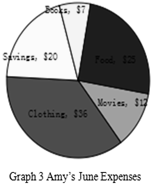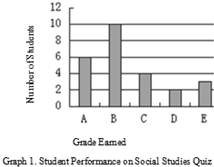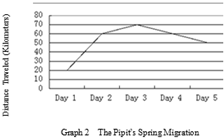6.Graphs can be a very useful tool for conveying information,especially numbers,percentages,and other data.A graph gives the reader a picture to interpret.That can be more efficient than pages and pages explaining the data.
Graphs can seem frightening,but reading a graph is a lot like reading a story.The graph has a title,a main idea,and supporting details.You can use your active reading skills to analyze and understand graphs like any other text.
Most graphs have a few basic parts:a caption or introduction paragraph,a title,a legend or key,and labeled axes.An active reader looks at each part of the graph before trying to interpret the data.Captions will usually tell you where the data from (for example,a scientific study of 400 African elephants from 1980 to 2005).Captions usually summarize the author's main point as well.The title is very important.It tells you the main idea of the graph by stating what kind of information is being shown.A legend,also called a key,is a guide to the symbols and colors used in the graph.Many graphs,including bar graphs and line graphs,have two axes that form a corner.Usually these axes are the left side and the bottom of the graph.Each axis will always have a label tells you what each axis measures.
The unit of measurement for the x-axis is days.The unit of measurement for the y-axis is kilometers.Thus we can see that,on the first day,the pipit flew 20 kilometers.The line segment goes up between Day 1 and Day 2,which means that the bird flew farther on Day 2.If the line segment angled down,as between Day 4 and Day 5,it would mean that the bird flew fewer kilometers than the day before.This line graph is a quick,visual way to tell the reader about the bird's migration.
Pie Graphs
A typical pie graph looks like a circular pie.The circle is divided into sections,and each section represents a fraction of the data.The graph is commonly used to show percentages; the whole pie represents 100 percent,so each piece is a fraction of the whole.A pie graph might include a legend,or it might use icons or labels within each slice.This pie graph shows one month's expenses(See Graph 3).
Food 25 Movies12 Clothing 36Savings20 Books $7
45.When used in a graph,a legend isA.
A.a guide to the symbols and colors
B.an introduction paragraph
C.the main idea
D.the data
46.What is the total number of students who earned a C or better?D
A.4.
B.6.
C.10.
D.20.
47.The bird covered the longest distance onC.
A.Day 1.
B.Day 2.
C.Day 3.
D.Day 4.
48.Which of the following cost Amy most?D
A.Food.
B.Books.
C.Movies.
D.Clothing.
Graphs can seem frightening,but reading a graph is a lot like reading a story.The graph has a title,a main idea,and supporting details.You can use your active reading skills to analyze and understand graphs like any other text.
Most graphs have a few basic parts:a caption or introduction paragraph,a title,a legend or key,and labeled axes.An active reader looks at each part of the graph before trying to interpret the data.Captions will usually tell you where the data from (for example,a scientific study of 400 African elephants from 1980 to 2005).Captions usually summarize the author's main point as well.The title is very important.It tells you the main idea of the graph by stating what kind of information is being shown.A legend,also called a key,is a guide to the symbols and colors used in the graph.Many graphs,including bar graphs and line graphs,have two axes that form a corner.Usually these axes are the left side and the bottom of the graph.Each axis will always have a label tells you what each axis measures.
| Bar Graphs A bar graph has two axes and uses bars to show amounts.In Graph 1,we see that the x-axis shows grades students earned,and the y-axis shows how many students earned each grade.You can see that 6 students earned an A because the bar for A stretches up to 6 on the vertical measurement.There is a lot of information we can get from a simple graph like this (See Graph 1) |  |
| Line Graphs A line graph looks similar to a bar graph,but instead of bars,it plots points and connects them with a line.It has the same parts as a bar graph---two labeled axes---and can be read the same way.To read a line graph,it's important to focus on the points of intersection rather than the line segments between the points.This type of graph is most commonly used to show how something changes over time.Here is a graph that charts how far a bird flies during the first five days of its spring migration (See Graph 2). |  |
Pie Graphs
A typical pie graph looks like a circular pie.The circle is divided into sections,and each section represents a fraction of the data.The graph is commonly used to show percentages; the whole pie represents 100 percent,so each piece is a fraction of the whole.A pie graph might include a legend,or it might use icons or labels within each slice.This pie graph shows one month's expenses(See Graph 3).
Food 25 Movies12 Clothing 36Savings20 Books $7

45.When used in a graph,a legend isA.
A.a guide to the symbols and colors
B.an introduction paragraph
C.the main idea
D.the data
46.What is the total number of students who earned a C or better?D
A.4.
B.6.
C.10.
D.20.
47.The bird covered the longest distance onC.
A.Day 1.
B.Day 2.
C.Day 3.
D.Day 4.
48.Which of the following cost Amy most?D
A.Food.
B.Books.
C.Movies.
D.Clothing.
5.Mr.Lee hasn't arrived.But it's already 9o'clock.He should ________ at any time.( )
| A. | turn up | B. | bring up | C. | look up | D. | pick up |
4.-You seem a little upset.What's the trouble?
-Nothing serious.The TV play me of those sad days.( )
0 140285 140293 140299 140303 140309 140311 140315 140321 140323 140329 140335 140339 140341 140345 140351 140353 140359 140363 140365 140369 140371 140375 140377 140379 140380 140381 140383 140384 140385 140387 140389 140393 140395 140399 140401 140405 140411 140413 140419 140423 140425 140429 140435 140441 140443 140449 140453 140455 140461 140465 140471 140479 151629
-Nothing serious.The TV play me of those sad days.( )
| A. | recovers | B. | remembers | C. | requires | D. | reminds |